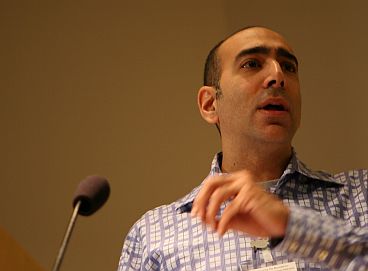One day before the Gaza ceasefire began, an Israeli soldier directs a Merkava tank onto a flatbed truck in an army camp along the border with Gaza Strip, 18 June 2008. (Menahem Kahana/AFP/Getty Images)
Te gast: Ali Abunimah, van The Electronic Intifada
Rays of hope from the Gaza ceasefire
After the unremitting hell that Israel has inflicted on Palestinians in Gaza, one can only feel relief and even joy at the ceasefire agreed between Hamas and the Jewish state that took effect this week. Its significance extends well beyond Gaza and opens new possibilities as the disastrous Bush Doctrine begins to lose influence.
Since the beginning of this year, Israeli occupation forces and settlers have killed over 400 Palestinians, including dozens of children and several babies, already exceeding the entire death toll for 2007. One hundred and fifty were killed during a few days of Israeli bombing of Gaza in early March. This year seven Israelis have been killed in conflict-related violence, including four by mortars or rockets fired from the Gaza Strip.
Some have sought to exclusively blame Hamas for the high Palestinian death toll, saying that the rockets resistance fighters were firing into Israel were “useless” and “toys,” and gave Israel the excuse to “retaliate” implying that resistance itself was to blame for the occupier’s violence. But the fallacy of this claim is exposed by the fact that the absence of rockets fired from the West Bank and the renunciation of resistance by the US-backed Palestinian Authority of Mahmoud Abbas in Ramallah, has not spared Palestinian communities there from daily and escalating Israeli violence.
Israeli soldiers and settlers have killed dozens of Palestinians all over the West Bank and injured hundreds of others, including many civilians in their homes, or taking part in peaceful demonstrations against the ongoing destruction and seizure of their land. According to the Palestinian Centre for Human Rights, up to mid-June, Israeli occupation forces had carried out over 827 military incursions into West Bank communities (an average of five per day) and had kidnapped or arrested 1,334 civilians since the start of the year. In addition to land confiscation and settlement construction, the Israeli army ransacked, destroyed or closed dozens of non-governmental organizations, radio stations, bakeries and other civic institutions and demolished many homes in the West Bank.
Abbas’ appointed prime minister Salam Fayyad called on Israel to extend the truce to the West Bank, demanding “All those Israeli military operations in areas under our control must cease.” Although Hamas has announced it will unilaterally observe the truce in the West Bank, Israel has not agreed to extend it there.
Israel’s massacres in Gaza were never about stopping rocket fire; as Israeli leaders repeatedly stated, they were intended to break the will of the civilian population and force it to turn against the resistance factions and towards the US and Israeli-backed Ramallah Authority. If Israel had wanted to stop the rockets the easy way to do that would have been to accept any one of the truce offers repeatedly proffered by Hamas.
Instead, as Haaretz’s Akiva Eldar put it, Hamas by refusing to buckle under, “once again proved that force is the only language Israel understands.” Hamas has achieved a mutual ceasefire and negotiations with Israel are under way to reopen Gaza crossings and exchange prisoners.
The ceasefire also suggests that — at least for now — Hamas has managed to achieve some measure of tactical deterrence. Despite constant Israeli threats to wage an all-out war in Gaza, there is a pervasive sense among Israelis that “a lengthy presence, even partial, in the Gaza Strip could turn into a copy of the First Lebanon War, where our soldiers became sitting ducks, targets of roadside bombs and ambushes, for 18 years,” as Haaretz military analyst Yoel Marcus put it.
The Israel-Hamas agreement underscores the failure of the policy of military terror, siege and starvation against Gaza supported by the US, the EU and some Arab states. But it also fits into a wider regional picture of the declining influence of the Bush Doctrine.
For years, the US has tried to divide the region into US-backed “moderates” (Jordan, Egypt, the Gulf states, Abbas’ Palestinian Authority and the Fouad Siniora government in Lebanon) in an alliance anchored by Israel and Saudi Arabia, and arrayed against so-called “extremists” (including Hamas, Hizballah and Syria) whom the US alleged were mere pawns of Iran.
The US banned its clients from having any dealings with “extremists,” even though this brought Palestine and Lebanon to the brink of civil war. Despite constant injunctions by US Secretary of State Condoleezza Rice that talking to the “extremists” is useless, governments are doing it anyway. If not peace, then rapprochement has been breaking out all over the place: after tense confrontations and fighting in May, the Lebanese government and Hizballah-led opposition struck a power-sharing accord mediated by Qatar. Israel and Syria have been engaged in negotiations mediated by Turkey. The Gulf States have moved to patch up relations with Iran.
Even Jordan’s King Abdullah II, who coined the notorious term “Shiite Cresent” to describe the sphere of influence Iran is allegedly trying to create, has backed off. Asked by The Washington Post’s Lally Weymouth last week if he viewed “Iran as the number one threat in this region,” he answered, “I think the lack of peace [between Israel and the Palestinians] is the major threat” and warned as he has before that time for a “two-state” solution was about to run out. The “major threat to the region,” the king asserted, was the prospect of “another 60 years of ‘fortress Israel.'” (Perhaps baffled that the king was off-script, Weymouth asked again, “But aren’t you concerned that Iran is a threat both to your country and to other countries in the region?” Again he did not take the bait.)
The most spectacular shift on the Palestinian front is that Abbas, after refusing to talk to Hamas for a year, on Rice’s orders, has opened an unconditional dialogue aimed at restoring power-sharing. Many Palestinians hope this could bolster national unity and put Palestinians in a better position to formulate a joint strategy for peace talks in the long-run, and to face Israeli aggression in the immediate future.
The Gaza ceasefire provides an opportunity, slim though it may be, to fundamentally change the course of Israeli-Palestinian relations. This depends first on Israel and its backers using the opportunity to recognize that they must now deal with Hamas as an integral and indispensable part of the Palestinian scene and move gradually from ceasefire and conflict management talks to a political dialogue. The US-British dialogue with the Irish Republican Army which led to peace in Northern Ireland remains an excellent model.
Second, Abbas has a short time to show whether he can act independently of the US, Israel and his corrupt entourage which thrives on internal conflict, and rebuild internal unity. (This is by no means certain — already there is jockeying to succeed him should the US or Israel abandon him as a result of his thawing relationship with Hamas.) If any of these parties tries to use the calm as a chance to prop up their failed strategy of isolating Hamas and the resistance it will guarantee a descent into misery.
The shadow that hangs over the region is the US and Israeli escalation towards Iran. For while Arab states have backed away from confrontation, and other adversaries are talking to each other, the US continues to threaten another war. As frightening as that prospect is, let us hope that the rays of hope emerging from Gaza will spread.
Co-founder of The Electronic Intifada, Ali Abunimah is author of One Country: A Bold Proposal to End the Israeli- Palestinian Impasse (Metropolitan Books, 2006).


